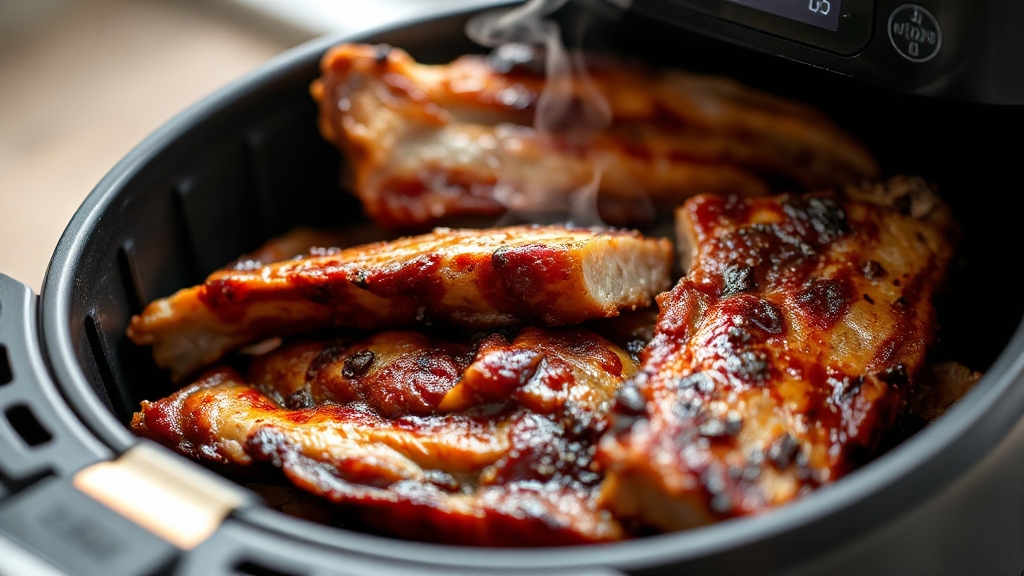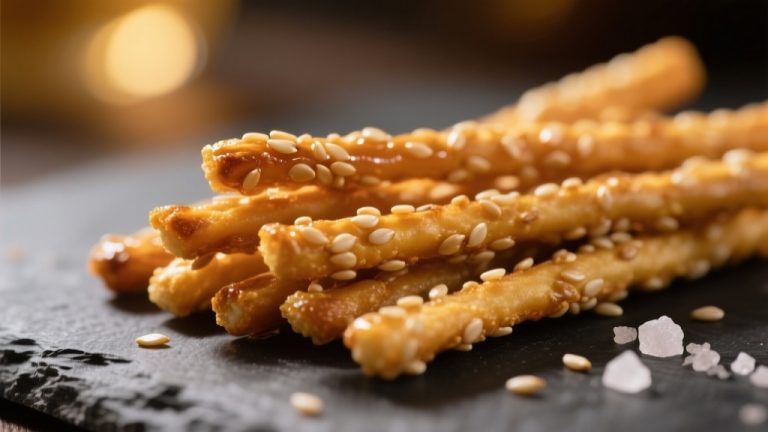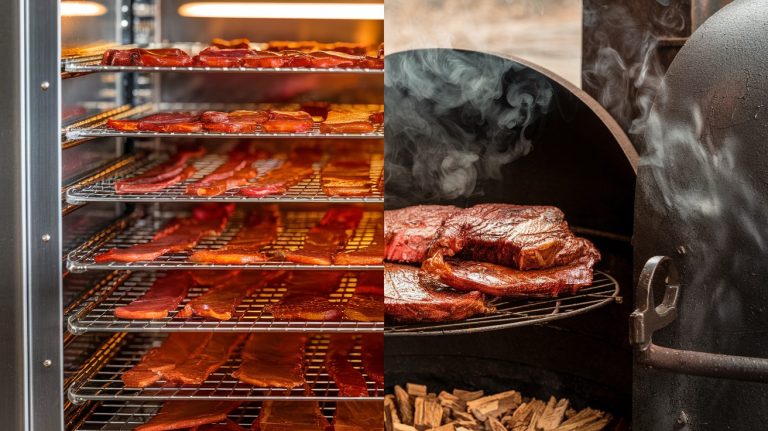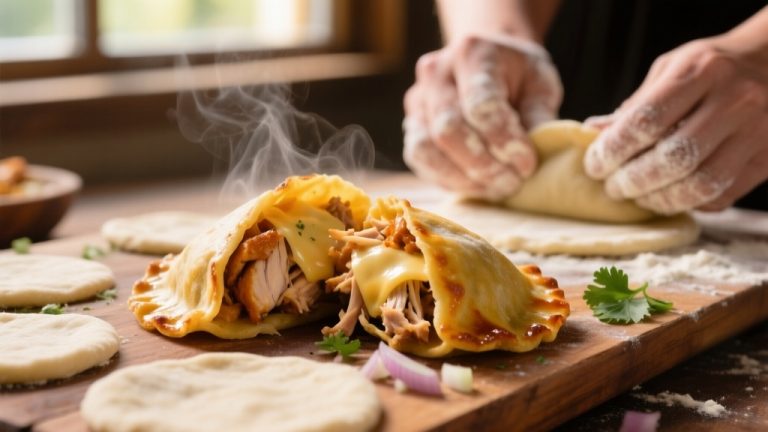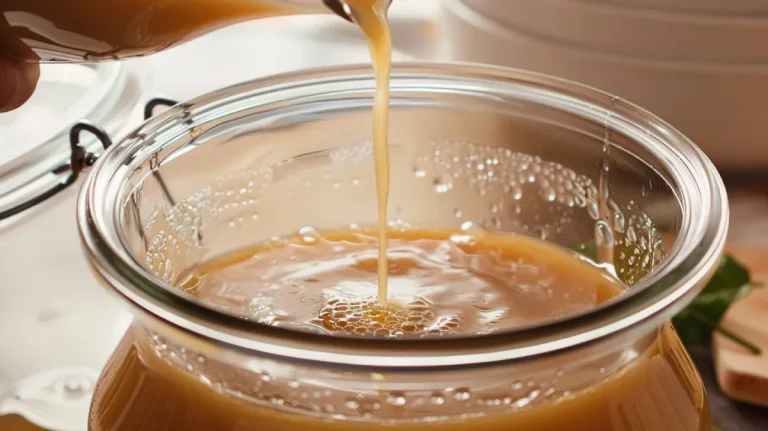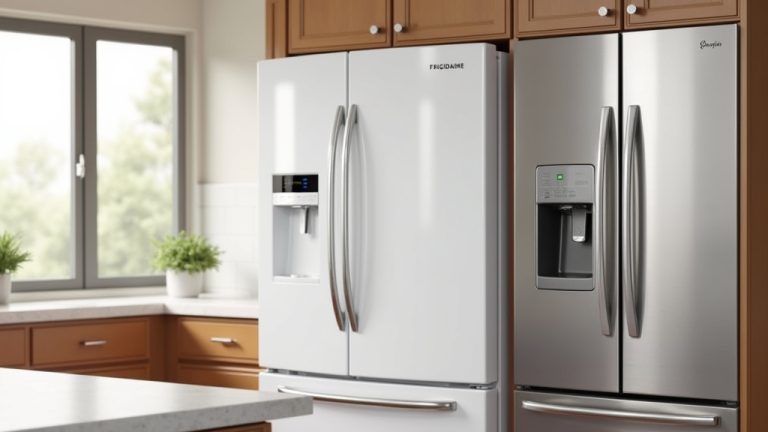Can You Reheat Ribs in an Air Fryer? Tips for Tender Bites
You can definitely reheat ribs in an air fryer, and it’s a great way to keep them juicy and flavorful.
Just preheat your air fryer to around 350°F, arrange the ribs in a single layer with a bit of water in the basket to lock in moisture, and heat for 3 to 5 minutes, flipping halfway through.
This method restores that tasty crisp without drying them out. Keep going to discover tips on making your reheated ribs taste like freshly cooked.
Key Takeaways
- Yes, ribs can be effectively reheated in an air fryer for quick, even warming with retained juiciness.
- Preheat the air fryer to 350°F-380°F and reheat ribs for 3-5 minutes, flipping halfway through.
- Arrange ribs in a single layer bone side down, adding water to the basket to maintain moisture.
- Use a meat thermometer to ensure ribs reach a safe internal temperature of 165°F before serving.
- Applying barbecue sauce in the last 1-2 minutes enhances flavor without drying out the ribs.
Optimal Temperature and Time for Reheating Ribs
When reheating ribs in an air fryer, choosing the right temperature and time is key to preserving their juiciness and flavor.
Aim for a temperature between 350°F and 380°F to balance thorough reheating with moisture retention. Preheat your air fryer to this range to guarantee even warming.
Generally, 3 to 5 minutes is a good starting point—flip the ribs halfway through if they’re thick or plentiful, then check for doneness. For best results, heat ribs to an internal temperature of 165°F to confirm safety without drying them out.
To reduce smoke caused by fat drippings during the reheating process, adding a tablespoon of cold water to the air fryer basket can be very effective.
You can push up to 400°F for a crispier exterior, but watch closely to avoid drying. Staying within this temperature and time window helps keep your ribs tender and delicious every time.
Preparing and Arranging Ribs for Air Fryer Reheating
Proper preparation and thoughtful arrangement of ribs set the foundation for perfectly reheated results in your air fryer. First, remove ribs from packaging and let them sit at room temperature to heat evenly.
Adding a tablespoon of water to the basket helps maintain moisture. The air fryer’s hot air circulation technology allows for quick reheating while preserving flavor.
Arrange ribs in a single layer, leaving space between pieces to maximize airflow and crispness.
| Step | Tip |
|---|---|
| Preparation | Remove packaging, let ribs warm up |
| Arrangement | Single layer, avoid overcrowding |
| Positioning | Bone side down, flip halfway |
Use tongs to place ribs gently, avoiding stacking. If ribs don’t fit, reheat in batches to guarantee an even, delicious finish.
Techniques to Retain Moisture and Flavor
Although reheating ribs might seem straightforward, preserving their moisture and flavor requires specific techniques that you can easily master.
To keep your ribs juicy and delicious, focus on these key strategies:
- Add a tablespoon of cold water to the air fryer basket to create steam, locking in moisture as the ribs reheat.
- Apply barbecue sauce in the last 1-2 minutes to refresh flavor without burning the sugars.
- Arrange ribs in a single layer with space around each piece to promote even air circulation and prevent drying. It is important to preheat air fryer before adding the ribs for optimal heating.
- Reheat at moderate temperatures (350°F–380°F) for 3-7 minutes, flipping halfway, and use a meat thermometer to hit 165°F without overcooking.
Benefits of Using an Air Fryer for Reheating Ribs
Mastering moisture and flavor retention sets the stage for appreciating why an air fryer stands out as a top choice for reheating ribs.
Master moisture and flavor to see why air fryers excel at reheating ribs perfectly every time.
You benefit from fast, even heating that locks in juiciness while restoring the ribs’ crispy bark. The air fryer’s rapid hot air circulation heats ribs uniformly, eliminating cold spots common in microwaves.
Its compact chamber speeds reheating to just 5–10 minutes at 350°F–400°F, preserving tenderness by preventing overcooking. Many users report satisfactory results when using this method, highlighting its effectiveness.
You’ll enjoy a crispy exterior without drying out the meat, unlike steaming or covered oven methods. Plus, the air fryer uses less energy and offers convenient controls, making it ideal for quick, hassle-free reheating.
Safety Measures and Quality Checks When Reheating
When reheating ribs, confirming they reach a safe internal temperature of 165°F is essential to prevent foodborne illness.
Use a reliable meat thermometer to check the thickest part of the ribs, and avoid relying solely on time since size varies.
Before reheating, let ribs rest at room temperature for 10–30 minutes to promote even heating. This step also helps the ribs retain their moisture during the reheating process. Keep these tips in mind:
- Preheat your air fryer and avoid overcrowding for proper hot air circulation.
- Lightly spritz ribs with apple juice or broth to lock in moisture and prevent drying.
- Flip ribs halfway through reheating to confirm uniform warmth and avoid soggy bottoms.
- Consume reheated ribs promptly and never reheat them multiple times to reduce bacterial risk.
Frequently Asked Questions
Can I Reheat Ribs in an Air Fryer Without Preheating It?
Yes, you can reheat ribs in an air fryer without preheating. Just place the ribs in a single layer, drizzle a little oil to keep them juicy, and set the temperature between 350°F and 400°F.
Flip the ribs halfway through reheating to guarantee even cooking. It might take a bit longer, so keep an eye on them to avoid drying out. Using a meat thermometer helps you nail the perfect warmth every time.
What Should I Do if My Air Fryer Basket Is Too Small for All Ribs?
When your air fryer basket is too small, remember: “Good things come in small batches.” Preheat your air fryer to 350°F–380°F, then reheat ribs in single layers without overcrowding.
Give ribs space for air circulation and reheat multiple batches if needed. Add a splash of water or broth to keep them moist, baste with BBQ sauce near the end, and keep finished ribs warm in a covered dish for juicy, tender results.
Is It Okay to Reheat Sauced Ribs Directly in the Air Fryer?
You can definitely reheat sauced ribs directly in your air fryer. Just brush them with a bit of extra sauce to keep them moist and warm them at around 350°F for 3-5 minutes per side.
Watch closely to avoid burning, especially if your sauce is thick or sticky. Leaving space between ribs helps even cooking, and using a drip tray prevents mess and smoke. This method crisps the sauce while locking in juicy flavor.
Can I Use Parchment Paper or Silicone Liners When Reheating Ribs?
Did you know that using parchment paper or silicone liners can cut cleanup time by up to 50%? You can definitely use either when reheating ribs, especially if they’re sauced. Just make sure the liners are perforated to keep airflow flowing—this prevents soggy ribs and uneven heating.
Silicone liners are reusable and eco-friendly, while parchment paper is disposable and convenient. Both help keep your air fryer basket clean without sacrificing rib quality.
How Does Reheating Ribs in an Air Fryer Affect Their Nutritional Value?
When you reheat ribs in an air fryer, you’ll preserve most of their nutrients like protein and minerals because the quick, moderate heat avoids overcooking. You won’t add extra fat, so calories stay steady, and some fat even renders off, slightly reducing fat content.
Just keep the temperature around 350°F and reheating time short to maintain juiciness, flavor, and nutritional value without drying them out or losing important nutrients.
Perfectly Reheated Ribs Every Time with Your Air Fryer
Reheating ribs in an air fryer is quick and keeps them juicy, with 70% of users reporting better texture than microwaving. Set the temperature around 350°F and heat for 5-7 minutes, flipping halfway.
By arranging ribs properly and wrapping them lightly, you lock in moisture and flavor. Plus, the air fryer’s even heat guarantees your ribs stay tender and tasty every time. Give it a try—you’ll love the results.

